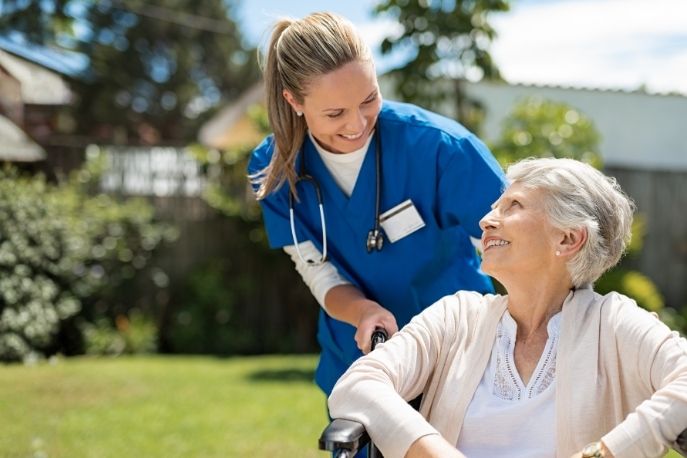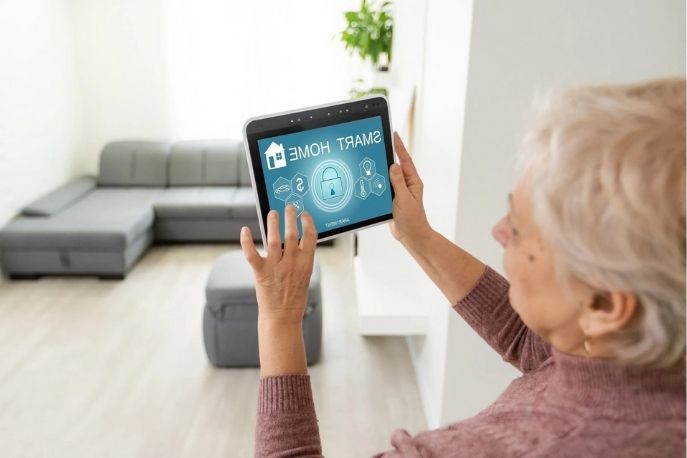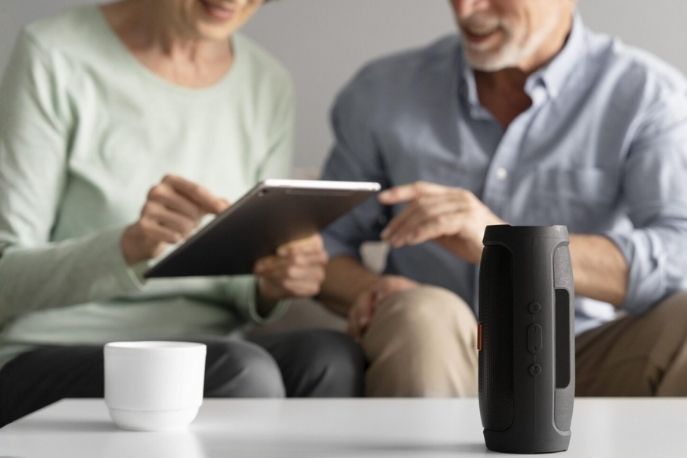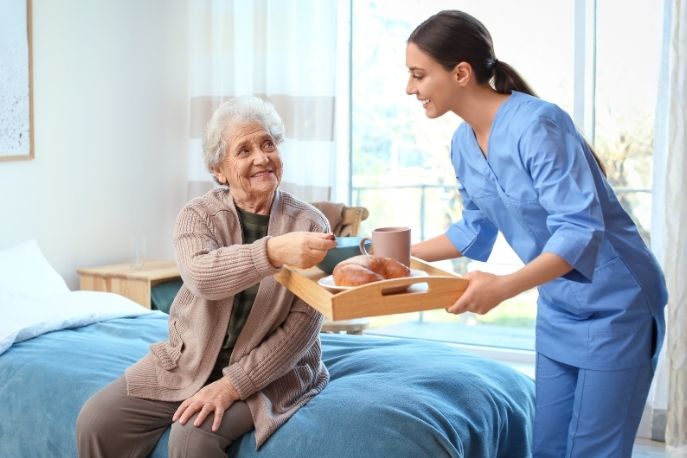-
Call us now +91 77770 79797 +91 96996 96997
-
Write to us now [email protected]
| Table of Contents
Introduction What Is Technology in Elder Care? Why Technology Matters in Elder Care? 6 Modern Devices for Elderly Care To Improve Their Safety and Independence 1. Smart Medication Boxes 2. Camera Systems 3. WanderGuard Systems 4. Voice-Activated Smart Assistants 5. Telehealth & Remote Monitoring Tools 6. Smart Home Automation Systems
How to Set Up Smart Technology for Older Adults 1. Identify Needs First 2. Start with Simple Devices 3. Introduce Technology Gradually 4. Provide Guidance and Support 5. Maintain and Review
Challenges in Implementing Elder Care Technology in India & How to Overcome Them Bottom Line: From Safety to Independence Frequently Asked Questions |
The elderly population in India is increasing at an unprecedented rate. The National Statistical Office (NSO) estimates that in 2022, there were 149 million people aged 60 and above in India, and this figure is predicted to go up to 194 million by 2031, which would account for approximately 13% of the total population.
Moreover, due to urban migration and smaller families, almost 25% senior citizens now living alone or with only one spouse are over 60 years old.
The above-mentioned factors have created a new market for elder care technology in India, a field that merges creativity and care in order to provide safety, comfort, and autonomy to the older population.
India is now open to various solutions that guarantee the safety and dignity of its senior citizens who are aging. Let’s get into more details here about the technology for elderly care, read below right now.

Elder care technology means smart gadgets and systems intended to keep the elderly living safely, easily, and more connected daily. Among such devices are:
India is going through a whole lot of changes: the young people usually leave for better job opportunities, and the old ones choose to live in smaller houses or alone.
Accordingly, the conventional caregiving approaches are being challenged. But on the other side, elder care technology India is a new source of filling such gaps.
Technological innovations have made it possible for elderly people to be in close touch with their family and friends, to go on with their daily lives, and to be notified in case of an emergency.
Take the example of a senior person who wears a device that can tell when such a person falls and who can alert the family members. The families of such seniors would be a little more reassured. No longer is this technology something of the future—it is already practical and is being adopted more in countries like Japan and also in Indian households.

In the year 2025, the care of the elderly is being completely transformed by technology, which is the combination of intelligent gadgets, surveillance devices, and machines working together. The use of these gadgets not only ensures the health of the elderly but also eliminates the worries of the families and at the same time, they are helping the elderly to live respectfully and independently.
Smart medication boxes are a great example of technology for elderly care. They cater to elderly patients who take several medications every day and would require a well-organized, dependable system. Up-to-date smart pill dispensers have been equipped with different compartments, alarms, and mobile notifications that come pre-programmed. Some of the advanced models even provide the capability to connect with cloud platforms so that doctors can monitor the patient’s adherence.
Example: A smart medication box used by a 70-year-old retired teacher in Mumbai takes care of his morning and evening doses through reminders and also alerts his daughter if he happens to miss one. This integration of senior monitoring devices and technology prevents hospital visits due to missed medications.
The camera systems for both indoor and outdoor use form a core part of the senior monitoring devices. The motion-sensing cameras notify caregivers instantly when they detect any unusual activities like falls or wandering, for example. On the other hand, it can also flag an laert when a person has NOT moved for long periods, indicating something may be wrong. The majority of camera systems have now integrated mobile apps into their services, enabling families, no matter how far away – even in other cities or countries, to monitor seniors from afar. Advantages & Practical Impact:
Example: A senior in a Mumbai apartment tumbled down the stairs while trying to climb. A camera system picked up the incident and instantly alerted the family, who were able to help and call for medical assistance. This is a clear instance of how senior monitoring devices not only enhance safety but also support independent living.
The elderly are particularly prone to brain disorders like dementia and Alzheimer’s, thus requiring the utmost care. WanderGuard systems, which are meant to be used with such patients, never allow the users to be completely out of touch. Movement monitoring is done by either GPS or RFID technology, and caregivers are alerted the moment an old person crosses the boundary line of the designated safe area. The advantages & Practical Impact:
For example, a 75-year-old man with early-stage dementia in Mumbai is wearing a WanderGuard bracelet. When he went outside his garden, the system alerted his daughter, thus avoiding a potentially dangerous situation. This is one case that proves that technology for elderly care can provide both independence and security.
In supporting seniors through life automation assistance, voice-activated smart assistants are one of the technology types that are really nice to have and to use. Thus, such devices are going to be helpful in performing the same basic operations without the need for physical interaction with either a phone or a switch. Older people can get their medication reminders, alarms set, smart appliance control, and even have family interaction all through their voice commands. Benefits and Practical Impact:
Example: A senior citizen living in Mumbai manages to break away from the lock-up situation at home by making use of a voice assistant who helps him with turning on the lights, locking the doors, and getting reminders about drinking water and medications. She leads a safe life.
Telehealth instruments are one of the principal factors of senior monitoring devices. Such devices let the elderly monitor basic body functions like blood pressure, heart rate, and oxygen saturation, and all done at the same time when doctors get the signals. Video consultations and distance monitoring work together to lessen the continuous hospital visits, and along with that, provide medical help very quickly. Benefits & Practical Impact:
Example: An old lady in Mumbai is using a smart blood pressure monitor. Her weekly readings are automatically sent to her cardiologist who can make medication changes in an informed manner. This is a classic case of how technology for elderly Care uplifts both the seniors and caregivers.
The whole system of life automation assistance technologies has formed a secure and convenient environment for the elderly, with a long list of them all working together through Smart home automation. The convenience of the old market is through the use of lighting control, temperature regulation, and even monitoring systems that are integrated with health-wearable devices, security locks that can be controlled remotely, and motion detectors. Advantages and real-world effect:
Example: Motion detectors in the Indian city of Mumbai turn on and off the lighting in the room as and when an elderly person enters or leaves the room at night. On the other hand, smart locks and doors give protection against accidental injuries and the temperature control system also contributes to a comfortable environment. Besides, seniors are now able to speak out about their needs and even their demand for the appliances is being met.

The introduction of smart technology for the elderly, in general, would mean an increase in safety, independence, and comfort in their everyday lives. The main point is to do this slowly and to the end user’s advantage.
Begin with a senior’s daily difficulties analysis. Which of these aspects are the main ones: medication management, fall prevention, or home appliance control? Being aware of priorities will allocate the right devices to be picked.
First of all, make a user-friendly tool selection. Monitoring Devices for Elderly people such as health wearables or fall-detection sensors and Life Automation Assistance tools like voice assistants or motion sensor lights, are very quality starting points. Devices like these assure immediate benefits to the user and do not overburden the user at the same time.
A gradual transition is the best approach, so don’t go ahead and get all the gadgets installed at once. Begin with one or two most significant gadgets and gradually increase the number as the elderly person gets accustomed to them. For example, start with a smart pill organizer, then add a health wearable, move on to home automation.
It is important to provide an environment that promotes hands-on practice, and at the same time, very tangible and straightforward instructions should be supplied. Family, caregivers, or health professionals should participate in the process by assisting, changing settings, and monitoring the use.
Add it to a list of things to do to check the devices from time to time, to carry out the updates of the software constantly, and to confirm the proper functioning of the alerts and notifications. Actually this way, the system’s security, trustworthiness, and productivity will be kept up.

| Challenge | How to Overcome |
| Low Awareness and Tech Literacy | Conduct awareness campaigns, training sessions for seniors and caregivers, and provide simple, user-friendly devices. |
| High Cost of Devices | Promote local manufacturing, offer government or insurance incentives, and introduce affordable device alternatives. |
| Poor Connectivity in Rural Areas | Expand broadband and 4G/5G networks, develop offline-compatible devices, and use mobile-based solutions. |
| Data Privacy & Security Concerns | Implement encrypted communication, secure cloud platforms, and clear regulations for health data protection. |
| Cultural Resistance to Technology | Design culturally-sensitive devices, involve family members in training, and highlight the benefits of smart caregiving. |
| Limited Local Innovation | Encourage startups and research in India-specific elder care solutions, and collaborate with healthcare professionals for customized products. |
The elderly are provided with security, independence, and convenience through the adoption of the latest Indian technologies like Senior monitoring devices and Life automation assistance and more. Are you looking for the best senior care? Here is the answer: At Sahabhaav, we help families implement the best solutions for seniors’ needs with our luxurious accommodation. While many of the technologies mentioned above are more relevant in home care, we are also introducing new technologies that combine innovation, simplicity, and care to make daily life safer and more joyful for our residents. For more details, contact us right now.
Contemporary gadgets, wearables, voice control, and home automation, in particular, assist the elderly in safely accomplishing daily activities, thereby making them less dependent on their caregivers and at the same time encouraging their independence.
Definitely not. Sophisticated sensors, artificial intelligence alerts, and secured cloud systems are the ones responsible for the precise monitoring of health, movement, and emergencies for the elderly at home or in assisted living.
Absolutely yes. The new products come with user-friendly interfaces, voice commands, and mobile compatibility which allows seniors to use the gadgets without much help with confidence.